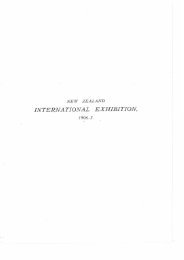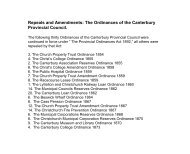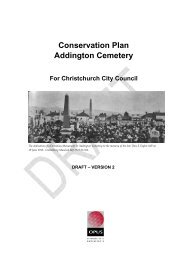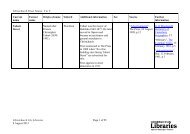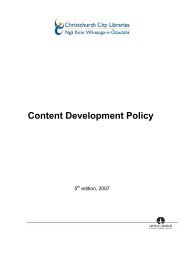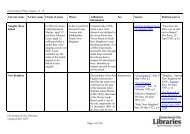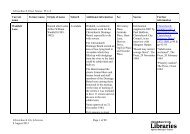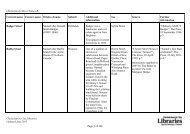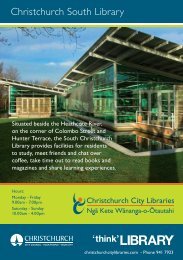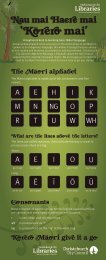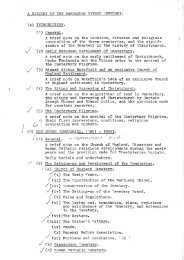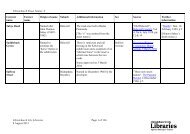Puawaitanga o te Ringa - Christchurch City Libraries
Puawaitanga o te Ringa - Christchurch City Libraries
Puawaitanga o te Ringa - Christchurch City Libraries
You also want an ePaper? Increase the reach of your titles
YUMPU automatically turns print PDFs into web optimized ePapers that Google loves.
Rhonda Rhonda Thomson Thomson (Käi Tahu, Käti Waewae). Working as an Arts Advisor - Mäori and<br />
Cultural at the <strong>Christchurch</strong> <strong>City</strong> Council, Rhonda joined NPW 2000. Rhonda provided<br />
the in<strong>te</strong>rface between <strong>Christchurch</strong> <strong>City</strong> Council and community volun<strong>te</strong>ers. Her expertise<br />
ensured that Ngä Puna Waihanga followed requisi<strong>te</strong> procedures to the let<strong>te</strong>r, so that<br />
applications for funding were appropria<strong>te</strong>ly targe<strong>te</strong>d and ultima<strong>te</strong>ly successful.<br />
Patricia Patricia Wallace Wallace (Ngäti Porou) grew up in <strong>Christchurch</strong>, without access to her cultural<br />
heritage. A former <strong>te</strong>acher, Tricia joined Ngä Puna Waihanga in 1993 while studying Mäori<br />
art history at the University of Can<strong>te</strong>rbury, and since 1995 has represen<strong>te</strong>d the Waitaha<br />
Tai Poutini region at national level. In 1996 she gradua<strong>te</strong>d B.A. (Hons) in Mäori and B.A. in<br />
Art History, with an emphasis on Mäori and Pacific arts; in 2002 she submit<strong>te</strong>d her Ph.D.<br />
thesis on traditional Mäori dress. Patricia’s role was research and planning of tukutuku<br />
designs, liaison with school and community groups, co-ordination of personnel and ensuring<br />
project continuity.<br />
The The Design Design Process<br />
Process<br />
Planning the pat<strong>te</strong>rns for nine<strong>te</strong>en different panels was an enormous but rewarding task.<br />
Despi<strong>te</strong> her years of experience, tutor Mae Taurua stood back to give the newcomers a<br />
free hand. Because the panels were to go in a Mäori resource area, it seemed appropria<strong>te</strong><br />
that the designs should provide another form of resource. It was decided to use conventional<br />
ma<strong>te</strong>rials, a colour palet<strong>te</strong> of earthy tones and to incorpora<strong>te</strong> a variety of traditional designs.<br />
Planning star<strong>te</strong>d by researching many sources as possible. Inspiration came from whare nui<br />
(meeting houses) and their dining halls (whare kai) and churches around the country such<br />
as Te Hau Ki Turanga at Te Papa, Te Hono Ki Rarotonga and Hine-Matikotai of Pakirkiri<br />
Marae, Te Whatu-Manawa Maoritangi O Rehua at Rehua Marae, Aoraki at Ngä Hau E Whä<br />
National Marae, St Faiths of Ohinemutu, the church at Putiki, the chapel and hospital of<br />
Gisborne Hospital, the chapel and the old hos<strong>te</strong>l of Te Wai Pounamu College, and from a<br />
range of published sources.<br />
Variations of traditional pat<strong>te</strong>rns that would show the creativity and diversity of the art<br />
form were chosen, with no two panels to be the same. The major pat<strong>te</strong>rns that allowed<br />
this development were poutama poutama, poutama the s<strong>te</strong>pped pat<strong>te</strong>rn of Ngäti Porou; roimata roimata, roimata the pat<strong>te</strong>rn<br />
based on the legend of albatross <strong>te</strong>ars; kaokao kaokao, kaokao the pat<strong>te</strong>rns of ribs or arms of warriors;<br />
niho niho taniwha taniwha, taniwha the wa<strong>te</strong>r-mons<strong>te</strong>r’s tooth; pütikitiki pütikitiki, pütikitiki based on the flounder; and mumu mumu, mumu the<br />
rectangular design from the Whanganui region. Other traditional designs included waharua waharua, waharua<br />
the double mouth; and purapura purapura whetu, whetu, the star seeding pat<strong>te</strong>rn. A special design<br />
incorporating the mountain Aoraki was crea<strong>te</strong>d to acknowledge the tangata whenua, Ngäi<br />
Tahu (see over page).<br />
The designs were planned on Excel spread sheets, which allowed the pat<strong>te</strong>rns to be centred<br />
and balanced. This sys<strong>te</strong>m enabled the adjustment of the number of kakaho to provide<br />
even or uneven numbers as each design required, and facilita<strong>te</strong>d planning the use of colours.<br />
P.W.<br />
11



